How to choose a pickleball paddle?
In the realm of pickleball, choosing a paddle is akin to selecting the right tool for a craft each component contributes to the overall effect on your performance. The paddle's weight, core material, grip size, and surface texture are some of the fundamental factors that play a significant role in your playing experience.
Key Factors to Consider
- Weight: The weight of the paddle affects how quickly and with what power you can swing it. Lighter paddles enable quicker movements, whereas heavier paddles yield greater power but can also lead to fatigue.
- Core Material and Thickness: The core of the paddle is critical for determining its feel and responsiveness. Common materials include polymer, Nomex, and aluminum, each affecting play differently based on their density and absorption qualities.
- Surface/Face Material: The paddle's face is typically composed of materials such as fiberglass, graphite, or carbon fiber. Each material impacts the paddle's control, power, and spin ability.
- Grip Size and Handle Length: Your grip needs to be comfortable to ensure control. Both grip size and handle length should be selected according to your hand size and preferences for maneuverability.
- Paddle Shape: The shape of the paddle can affect how it performs in various situations widebody paddles provide a larger sweet spot and are forgiving, while elongated paddles can offer more reach.
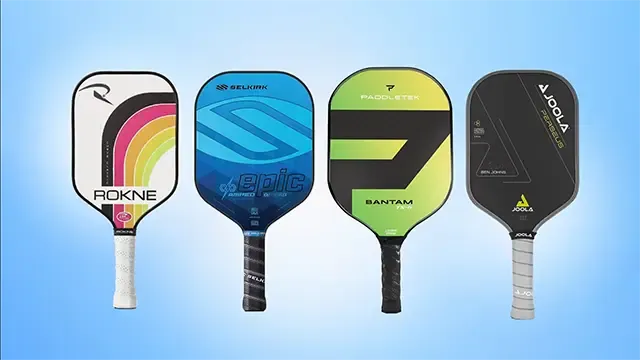
By paying close attention to these features, you can identify a paddle that contributes positively to your personal style of play and enhances your overall effectiveness on the court.
Decoding Paddle Weight: Finding Your Ideal Swing
Understanding paddle weight is essential, as it directly influences your swing speed, shot power, and fatigue level during play. The overall weight can have an immediate impact on your performance, shaping how well you wield the instrument that will be an extension of your arm on the court.

Static Weight, Swingweight, and Twistweight Explained
- Static Weight: This refers to the total weight of the paddle when it is at rest. On average, paddles weigh between 6 to 9 ounces. Lighter paddles (< 7.0 oz) are often preferred for their maneuverability, while heavier ones (> 8.5 oz) can offer added power and stability.
- Swingweight: This measures how heavy the paddle feels when in motion and is affected by its balance point. A paddle with a high swingweight may provide more power but can be less maneuverable, leading to quicker fatigue, especially in prolonged matches.
- Twistweight: This assesses how resistant the paddle is to twisting on contact, particularly when striking off-center. A paddle with high twistweight will offer a larger sweet spot, vital for maintaining accuracy and consistency during play.
By comprehensively evaluating each of these weight categories, players can align their paddle choice with their physical capabilities and playing style, ensuring they maximize their play potential.
Weight Ranges and Performance
The weight of pickleball paddles is generally categorized into three main ranges:
- Ultra-Light Paddles: Weighing under 7.0 ounces, these paddles are ideal for players seeking higher swing speed and the ability to react quickly to rapid volleys. They are often favored by beginners for developing hand-eye coordination.
- Light Paddles: Generally ranging from 7.0 to 8.5 ounces, these paddles offer a balanced blend of speed and control, suitable for most intermediate players. They provide enough heft to generate significant power without sacrificing quickness.
- Heavy Paddles: Weighing over 8.5 ounces, these paddles impart substantial force on the ball, ideal for aggressive players seeking to dominate from the baseline. They do require greater strength and stability from the player.
How to Determine Your Optimal Paddle Weight
Finding the perfect weight for your paddle is a personalized journey. Here are several methods:
- Weighing Your Current Paddle: If you currently have a paddle, weigh it to see where it fits in the weight ranges, and determine if it’s comfortable for you.
- Trying Different Paddles: It’s beneficial to test out paddles in your local store or courts. Swing various weights to find a comfortable compromise between control and power.
- Recognizing Signs of a Too-Light or Too-Heavy Paddle: If you’re experiencing fatigue early in play, it may indicate the paddle is too heavy. Conversely, if you find it challenging to direct your shots, a heavier paddle may be beneficial.
Every player has unique preferences, which emphasizes the importance of experimenting with weight to find the one that aligns with your style and enhances your performance on the court.
Core Matters: Exploring Materials and Thickness
Having established the importance of weight, we now turn our focus to the paddle core the internal structure that influences playability, including power and control. Choosing the right core material and thickness can significantly enhance your game.
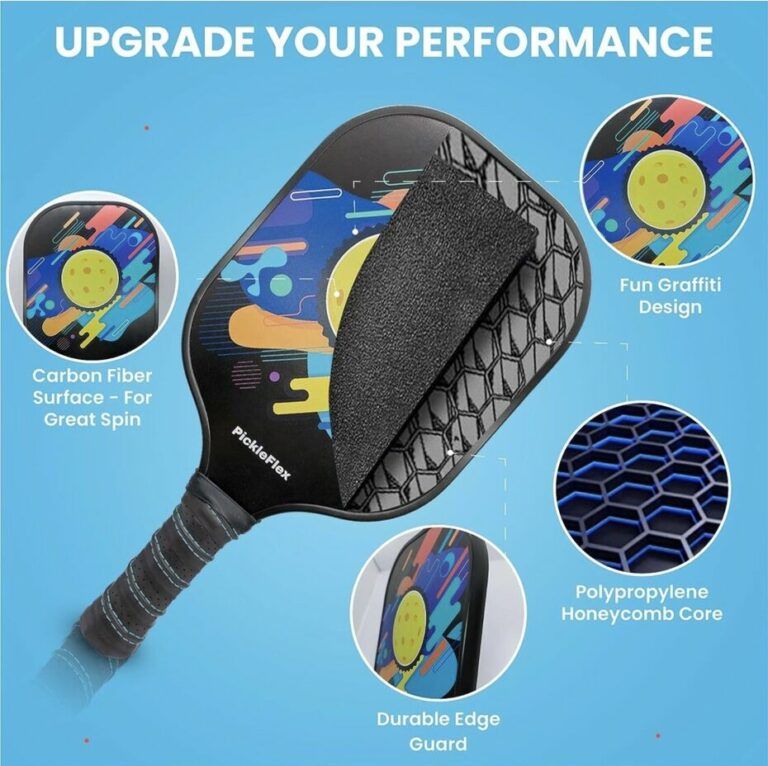
Core Materials Compared
Various core materials have become standard in paddle production. Here’s a closer look:
- Polymer/Polypropylene Cores: These are the most popular, strike a great balance between power and touch, and are quieter than their counterparts. Polymer-made paddles are known for their durability and responsiveness.
- Nomex Cores: Known for their exceptional power, Nomex cores are lightweight but can be a bit noisier during play. They can deliver an explosive hit but may lack some of the touch required for finesse shots.
- Aluminum Cores: These provide a solid feel and require less effort for powerful hits; however, they are not as commonly used due to perceived disadvantages in touch and noise levels.
- Wood Cores: Typically used in more budget-friendly paddles, wood can be heavier and offer less flexibility than composite cores, but they are durable and can withstand rougher play.
- Foam Cores: Known for enhanced touch and feel, foam provides a more forgiving play style ideal for controlled shots and with the potential to generate spin.
The Impact of Core Thickness
Core thickness is another vital factor in paddle performance, affecting everything from feel to control. Factors to consider include:
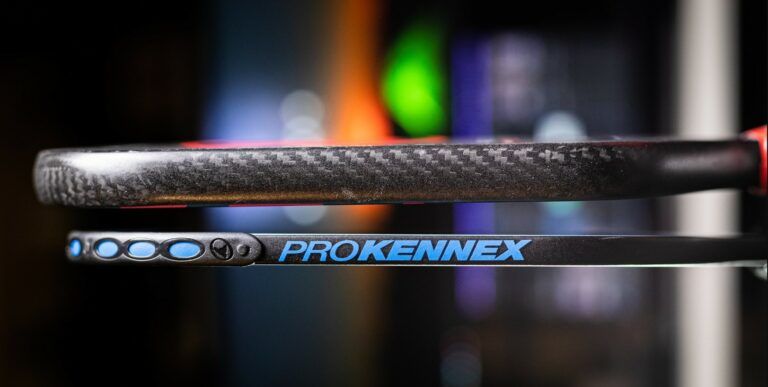
- Thinner Cores (≤ 14mm): These paddles emphasize power and speed, making them suitable for aggressive players who want direct energy transfer from the paddle to the ball.
- Medium Cores (around 15mm): Balancing between power and control, these cores cater to players looking for versatility, adapting well to varied styles of play.
- Thicker Cores (≥ 16mm): They offer a larger sweet spot and improved forgiveness on mishits. This is especially advantageous for beginners who may struggle with precision.
Hybrid Core Designs
Hybrid paddles leverage the strengths of different materials to create paddles that simultaneously provide power and touch. Common combinations are:
- Polymer and Nomex: The polymer base offers a quieter experience but is complemented by Nomex for explosive power.
- Aluminum and Foam: Combining the sturdy feel of aluminum with the soft touch of foam can produce a uniquely responsive paddle.
By understanding core materials and thickness, players can effectively tailor their choice to align with their individual playing style, ensuring they get the most out of their paddle.
Surface/Face Materials: Power, Control, and Spin
As we transition to the paddle's surface materials, it becomes clear that they play a significant role in determining how the paddle interacts with the ball. Both the material and texture of the paddle’s face can greatly influence power, control, and spin.

Understanding Surface Material Layups
Various configurations of material layering help optimize performance:
- Carbon Fiber: This is renowned for its strength-to-weight ratio. Paddles with carbon fiber faces often feature a robust construction that allows for powerful shots while maintaining excellent control ideal for advanced players.
- Fiberglass: Known for its elasticity, fiberglass paddles offer a lively response, translating to significant power. They generally provide a softer feel and prolong contact time with the ball, which aids in generating spins.
- Graphite: Graphite paddles are incredibly lightweight yet offer a stiff playing surface. They excel in fast-paced exchanges when precision matters most, catering to players who thrive on control.
- Composite: A blend of materials, composite paddles offer a versatile performance that balances power with finesse, making them a popular choice among all skill levels.
The Role of Texture in Spin Generation
The surface texture of a paddle can dramatically influence its ability to generate spin:
- Rough Textures: Paddles with applied textures create increased friction, helping players impart spin during contact. This is fundamental for advanced spin shots.
- Smooth Surfaces: While providing consistent ball placement, smooth-faced paddles may sacrifice a degree of spin generation. They are ideal for players who prioritize accuracy over spin.
- Textured Paddles: Combining the benefits of both types, textured paddles enhance a player's ability to control spin on serves and returns, critical in winning closely contested matches.
Understanding these features allows players to select paddles that complement their preferences for power and control, significantly improving their gameplay.
Grip and Handle: Comfort and Control in Your Hands
With a firm grasp on surface materials, we now turn our attention to the grip and handle of the paddle. The grip affects comfort and control, ultimately allowing players to wield their paddle effectively during games.
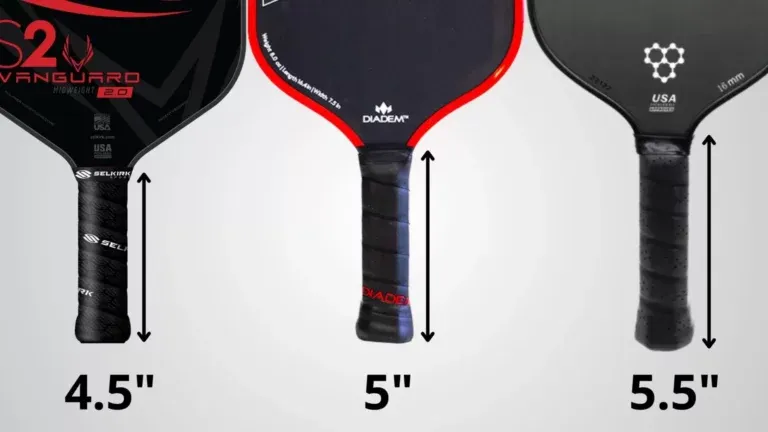
Finding the Right Grip Size
Choosing a comfortable grip size is crucial for maximizing control during play:
- Grip Size Options: Common grip sizes range from 4 to 4.5 inches. Selecting the appropriate circumference based on your hand size can prevent issues like tennis elbow or wrist strain from improper grip.
- Height Test: Stand upright and extend your dominant hand; your fingers should just touch the base of your palm for your optimal grip size.
- Finger Test: When holding the paddle, it is essential to check if your index finger can comfortably fit between your fingers and the base of your thumb. If it feels too tight or too loose, adjustments need to be made.
- Overgrips: In case the factory grip doesn't feel just right, adding an overgrip can help adjust the paddle’s diameter for personal comfort.
Handle Length and Its Influence
The handle length also significantly influences gameplay:
- Short Handles: Ideal for players who prefer maneuverability, short handles generally provide better control during quick exchanges.
- Standard Handles: Measuring about 4 to 5 inches, this size typically suits the average player and balances comfort with reach.
- Long Handles: Great for two-handed backhand shots, longer handles offer additional leverage but might sacrifice some maneuverability in quick net exchanges.
The perfect grip and handle alignment with play style contribute tremendously to optimizing comfort and control.
Paddle Shapes: Matching Shape to Your Style
Having discussed the core elements affecting paddle choice, let’s delve into paddle shapes, which play a pivotal role in tailoring the paddle to fit your individual style.
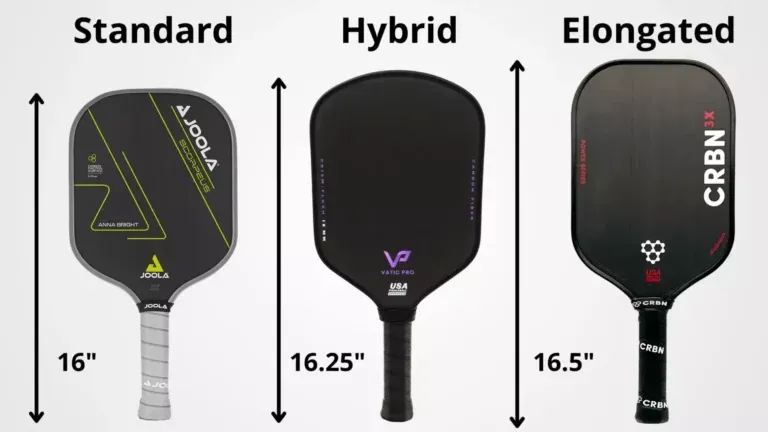
Exploring the Three Main Paddle Shapes
- Widebody (Standard) Shape: These paddles provide a larger sweet spot and enhance stability, making them ideal for beginners and those who enjoy a balanced approach to their play.
- Elongated Shape: With a slightly longer design, these paddles are suited for advanced players needing increased reach for powerful serves. However, they sacrifice some width in the sweet spot, requiring precision.
- Hybrid Shape: Combining features from both standard and elongated shapes, hybrid paddles offer versatility, catering to players who seek a balance between reach and control.
Understanding these paddle shapes allows players to select a model that complements their playing style and optimizes their performance on the court.
Advanced Considerations for Paddle Selection
With the fundamental aspects covered, let’s explore some advanced features critical for selecting the perfect paddle.
The Importance of Balance
Balance fundamentally affects how a paddle performs during play, and it can transform user experience significantly:
- Head-Heavy Paddles: These offer more power through the head but may impair maneuverability. Great for aggressive players who spend time at the baseline, relying on power-oriented shots.
- Handle-Heavy Paddles: Provide improved control and are capable of quick adjustments, especially in close exchanges at the net.
- Evenly Balanced Paddles: These provide a perfect blend of power and control, ideal for players who balance aggressive shots with finesse.
Exploring Paddle Customization Options
Customization can refine player experience; here are a couple of methods:
- Lead Tape: Applying lead tape allows players to adjust the paddle’s weight and balance for optimized swing characteristics.
- Grip Adjustments: Players can swap out grips easily to enhance comfort, leading to better control during matches.
Paying attention to balance and customization options can make a substantial difference in how effectively you can play and adapt on the court.
Matching Your Paddle to Your Game: Recommendations by Player Profile
Tailoring your paddle selection to your skill level and playing style is critical for performance. By understanding which features suit your playstyle best, you can enhance both control and power.
Best Paddles for Beginners
Beginners often benefit from paddles that prioritize forgiveness and ease of use, teaching them the basics without complicating factors.
- PIKKL Hurricane Pro: Known for its large sweet spot, this paddle helps beginners build confidence in gameplay.
- GoSports GS1: An excellent budget option, it provides decent pop and is ideal for newcomers developing their skills.
Intermediate Player Choices
As players transition from beginner to intermediate, they often seek paddles that enhance both power and control:
- SLK EVO Power 2.0 XL: Featuring a carbon fiber build, it successfully combines power and spin, ideal for evolving gameplay as skills sharpen.
- Electrum Model E 16mm: This paddle excels in control and provides the reach necessary for effective play.
Advanced Paddles for Competitive Play
Advanced players demand specific qualities from their paddles, including responsiveness and precision in fast-paced games:
- JOOLA Ben Johns Perseus CFS 16mm: With advanced construction that caters to aggressive play styles, this paddle offers remarkable control and powerful shots.
- Selkirk Vanguard Power Air Invikta: This lightweight paddle allows for quick movements while delivering powerful shots, making it a favorite among competitive players.
Specialized Paddles for Power, Control, or Spin
Picking the right specialty paddle is essential for honing in on gameplay strategies:
- For Power: Heavy paddles like the Engage Poach Infinity MX are ideal, delivering substantial force for power-oriented players.
- For Control: Mid-weight options such as Paddletek Tempest Wave Pro provide an ample sweet spot with precision shot placement.
- For Spin: Paddles featuring textured surfaces, such as the Selkirk Amped Epic, help enhance spin capabilities during play, crucial for competitive strategy.
Considerations for Former Tennis Players
Players coming from a tennis background often experience unique transition needs:
- Grip Styles: Look for paddles that match the grip circumference of your tennis racquet size.
- Power and Control Balance: Choose hybrid paddles that offer sufficient power without sacrificing control as you adapt to pickleball's nuances.
Ensuring that paddle selections align with individual profiles is essential for elevating gameplay transformation.
Caring for Your Pickleball Paddle
With paddle selection addressed, it’s equally important to consider maintenance and care practices to prolong the paddle's lifespan and maintain its performance:
Cleaning and Maintenance Tips
To keep your paddle in top shape:
- Regular Cleaning: Use mild soap and water, gently wiping down surfaces to prevent dirt buildup. A damp cloth works best for routine maintenance.
- Handle Care: After each use, clean the grip to remove sweat and oils, replacing grips if they become slippery or worn.
- Avoid Soaking: Never submerge your paddle in water, as moisture can damage the core. Instead, utilize a slightly damp cloth for cleaning.
Storage Best Practices
Proper storage practices can prevent damage and preserve your pickleball paddle:
- Environment: Store your paddle in a cool, dry place away from extreme temperatures which can warp or degrade materials.
- Using Protective Covers: Utilize covers or bags to protect it from dust and physical impact, ensuring durability during transportation.
Recognizing When It's Time for a Replacement
Keeping an eye on paddle condition can save you trouble in the long run:
- Visible Damage: Look out for cracks or chips that can lead to further wear and impact performance negatively.
- Declining Performance: If you notice reduced power, accuracy, or sound during play, it may indicate deterioration.
- Play Duration: Typically, paddles may need replacement after around 300 hours of play or when significant performance changes are recognized.
Proactive maintenance and care lead to a longer life for your paddle, sustaining its performance on the court and ultimately improving your overall experience.
Conclusion
Choosing the perfect pickleball paddle is a multifaceted process that requires careful consideration of various factors, including weight, core material, grip size, and shape. Each element plays a significant role in enhancing comfort, control, and performance while matching your skill level and playing style. Moreover, proper care ensures that your paddle continues to perform optimally for years to come.
By understanding how to navigate the options available and aligning your choice with your individual preferences, you can elevate your game and truly enjoy the dynamic sport of pickleball. Always remember that the right paddle not only enhances your capabilities but also enriches your overall playing experience, making every game more enjoyable. So gear up, choose wisely, and get ready to hit the courts with confidence!










